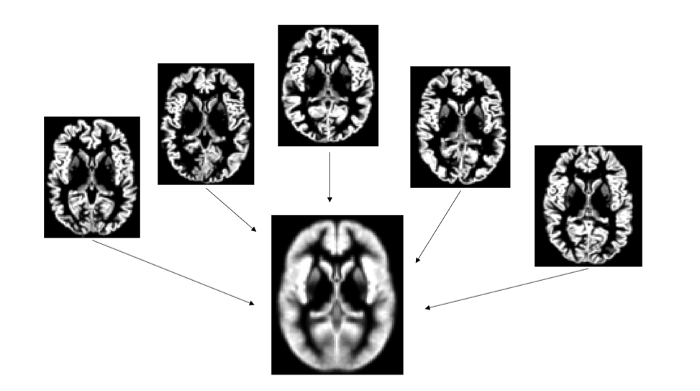Measuring Grey Matter Differences with Voxel-based Morphometry: The Musical Brain
Overview
Source: Laboratories of Jonas T. Kaplan and Sarah I. Gimbel—University of Southern California
Experience shapes the brain. It is well understood that our brains are different as a result of learning. While many experience-related changes manifest themselves at the microscopic level, for example by neurochemical adjustments in the behavior of individual neurons, we may also examine anatomical changes to the structure of the brain at a macroscopic level. One famous example of this kind of change comes from the case of the London taxi drivers, who along with learning the complex routes of the city show larger volume in the hippocampus, a brain structure known to play a role in navigational memory.1
Many traditional methods of examining brain anatomy require painstaking tracing of anatomical regions of interest in order to measure their size. However, using modern neuroimaging techniques, we can now compare the anatomy of the brains across groups of people using automated algorithms. While these techniques do not avail themselves of the sophisticated knowledge that human neuroanatomists may bring to the task, they are quick, and sensitive to very small differences in anatomy. In a structural magnetic resonance image of the brain, the intensity of each volumetric pixel, or voxel, relates to the density of the gray matter in that region. For example, in a T1-weighted MRI scan, very bright voxels are found in locations where there are white matter fiber bundles, while darker voxels correspond to grey matter, where the cell bodies of neurons reside. The technique of quantifying and comparing brain structure on a voxel-by-voxel basis is called voxel-based morphometry, or VBM.2 In VBM, we first register all of the brains to a common space, smoothing over any gross differences in anatomy. We then compare the intensity values of the voxels to identify localized, small scale differences in gray matter density.
In this experiment, we will demonstrate the VBM technique by comparing the brains of musicians with those of non-musicians. Musicians engage in intense motoric, visual, and acoustic training. There is evidence from multiple sources that that the brains of people who have gone through musical training are functionally and structural different from those who haven't. Here, we follow Gaser and Shlaug3 and Bermudez et al.4 in using VBM to identify these structural differences in the brains of musicians.
Procedure
1. Recruit 40 musicians and 40 non-musicians.
- Musicians should have at least 10 years of formal musical training. Training with any musical instrument is acceptable. Musicians should also be actively practicing their instrument for at least one hr/day.
- Control subjects should have little to formal training in playing a musical instrument.
- All participants should be right-handed.
- All participants should have no history of neurological, psychiatric, or cardiac disorders.
Results
The VBM analysis revealed significant localized increases in gray matter density in musicians' brains compared with non-musician controls. These differences were found in the superior temporal lobes on both sides. The largest, most significant cluster was on the right side and includes the posterior portion of Heschl's gyrus (Figure 2). Heschl's gyrus is the location of the primary auditory cortex, and the surrounding cortices are involved in complex auditory
Application and Summary
The VBM technique has the potential to demonstrate localized differences in gray matter between groups of people, or in association with a measurement that varies across a group of people. In addition to finding structural differences that relate to different forms of training, this technique may reveal anatomical differences that are associated with wide ranging neuropsychological conditions such as depression,5 dyslexia,6 or schizophrenia.7
It is important to
References
- Maguire, E.A., et al. Navigation-related structural change in the hippocampi of taxi drivers. Proc Natl Acad Sci U S A 97, 4398-4403 (2000).
- Ashburner, J. & Friston, K.J. Voxel-based morphometry--the methods. Neuroimage 11, 805-821 (2000).
- Gaser, C. & Schlaug, G. Brain structures differ between musicians and non-musicians. J Neurosci 23, 9240-9245 (2003).
- Bermudez, P., Lerch, J.P., Evans, A.C. & Zatorre, R.J. Neuroanatomical correlates of musicianship as revealed by cortical thickness and voxel-based morphometry. Cereb Cortex 19, 1583-1596 (2009).
- Bora, E., Fornito, A., Pantelis, C. & Yucel, M. Gray matter abnormalities in Major Depressive Disorder: a meta-analysis of voxel based morphometry studies. J Affect Disord 138, 9-18 (2012).
- Richlan, F., Kronbichler, M. & Wimmer, H. Structural abnormalities in the dyslexic brain: a meta-analysis of voxel-based morphometry studies. Hum Brain Mapp 34, 3055-3065 (2013).
- Zhang, T. & Davatzikos, C. Optimally-Discriminative Voxel-Based Morphometry significantly increases the ability to detect group differences in schizophrenia, mild cognitive impairment, and Alzheimer's disease. Neuroimage 79, 94-110 (2013).
Skip to...
Videos from this collection:

Now Playing
Measuring Grey Matter Differences with Voxel-based Morphometry: The Musical Brain
Neuropsychology
17.3K Views

The Split Brain
Neuropsychology
68.3K Views

Motor Maps
Neuropsychology
27.5K Views

Perspectives on Neuropsychology
Neuropsychology
12.0K Views

Decision-making and the Iowa Gambling Task
Neuropsychology
32.5K Views

Executive Function in Autism Spectrum Disorder
Neuropsychology
17.7K Views

Anterograde Amnesia
Neuropsychology
30.3K Views

Physiological Correlates of Emotion Recognition
Neuropsychology
16.2K Views

Event-related Potentials and the Oddball Task
Neuropsychology
27.5K Views

Language: The N400 in Semantic Incongruity
Neuropsychology
19.6K Views

Learning and Memory: The Remember-Know Task
Neuropsychology
17.1K Views

Decoding Auditory Imagery with Multivoxel Pattern Analysis
Neuropsychology
6.4K Views

Visual Attention: fMRI Investigation of Object-based Attentional Control
Neuropsychology
41.7K Views

Using Diffusion Tensor Imaging in Traumatic Brain Injury
Neuropsychology
16.7K Views

Using TMS to Measure Motor Excitability During Action Observation
Neuropsychology
10.1K Views
Copyright © 2025 MyJoVE Corporation. All rights reserved
